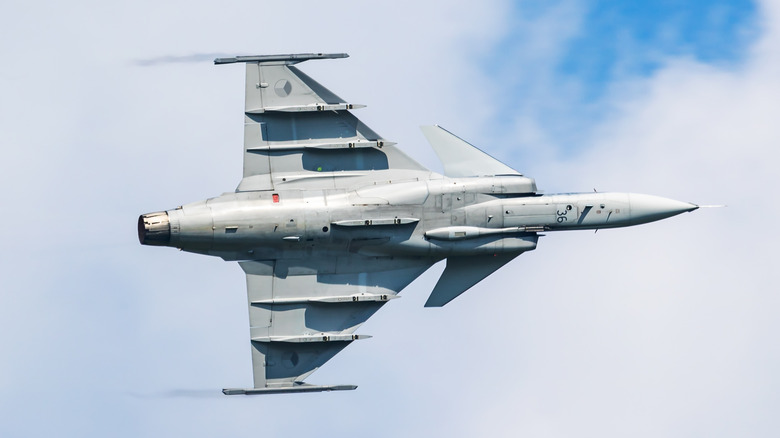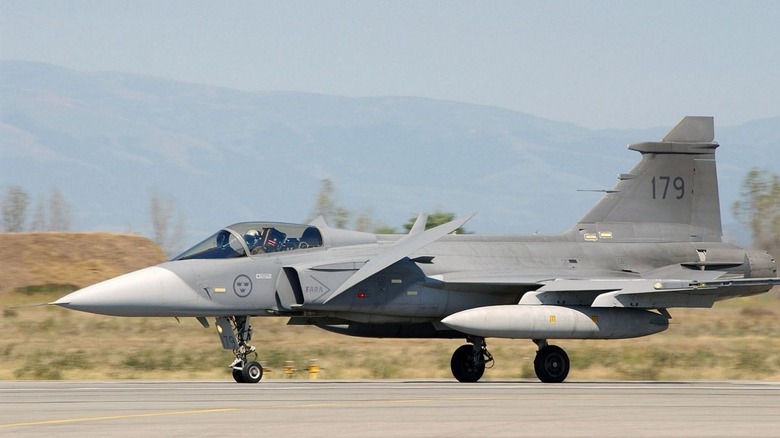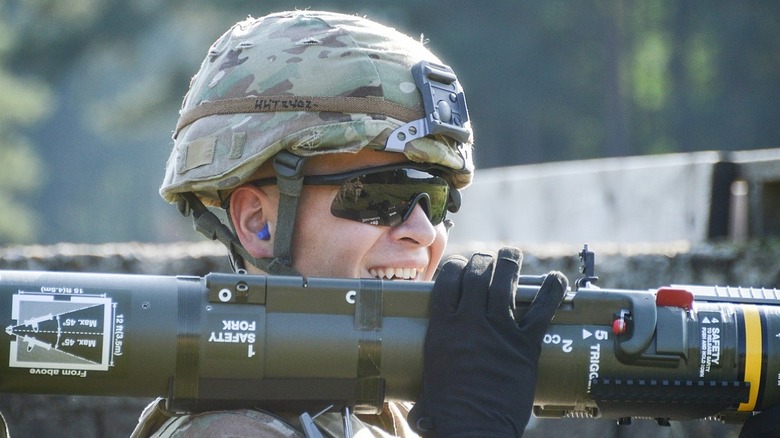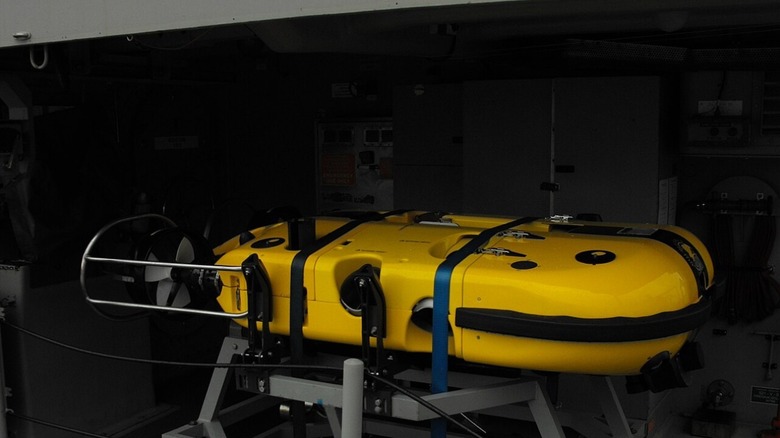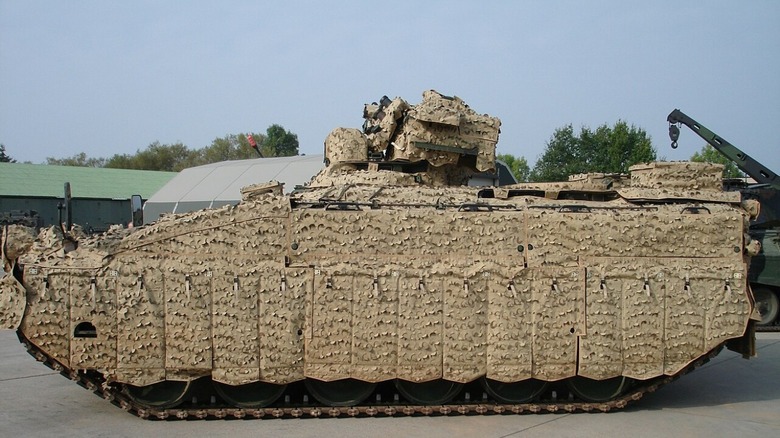What Does Saab Mean And What Kind Of Military Equipment Does It Make?
Sweden is a country quite well known for taking bold design directions and establishing its own distinctive product ranges. Saab, historically, has been known as an auto manufacturer. Though Saab Automobile has been out of business since 2011, it has a long legacy of making fascinating vehicles, like the iconic Saab 900 and the stylish Saab Sonett, that stretches back to its beginning in 1945.
One year after the auto maker's introduction came the Ursaab concept car, which the brand referred to as Project 92. It was the first car they made and was developed with a drag coefficient of a mere 0.3. The reason for this is that, at the time, Saab was an aero plane developer. After all, the name stands for Svenska Aeroplan Aktiebolaget, or Swedish Aeroplane Corporation. The broader military brand outdated the commercial vehicle one, beginning in 1937, which Saab explains was very timely. Its first goal was to "provide planes for the Swedish Air Force, just as Europe was steeling itself for another war."
Saab went on to develop a wide range of military vehicles, weapons, and other equipment. The company's output, over almost a century in the business, incorporates sophisticated weapons systems like the RBS15 family of anti-ship missiles and the AT4 single-use, disposable projectile launcher to eradicate armor. In a more supportive role, the family of Giraffe radar systems is just one innovation that helps keeps allies safe and in the know, while the Double Eagle underwater systems help detect and remove the danger of lurking mines. The big-ticket items of Saab's military output, though, are its vehicles, which include the JAS 39 Gripen fighter jet.
The Gripen fighter jet
Perhaps the best-known of Saab's military machines, the incredible Gripen fighter is a versatile and formidable model that seems set to have a significant role in the development of future conflicts. The first thing to ensure, with the development of a piece of technology as formidable, influential, and powerful as a new fighter jet, is that it has an appropriate name. Gripen, according to Saab, is derived from the name of the fearsome mythological griffin, and was the result of a groupthink inspired by a competition in the magazine "FlygvapenNytt." As a result, "a flight attendant named Helena Sillen suggested the name Gripen" in 1982.
It was officially unveiled four years later, and the first model of the jet entered service in 1997. It wasn't long at all before it became clear just how important this model would become to the nation's air force. Just five years after this, Saab Aeronautic's Jonas Hjelm declared the C and D models of the Gripen to be "the backbone of the Swedish Armed Forces today," going on to further predict that it would "continue to be for many years to come."
The Gripen E variant is certainly no slouch, capable of flight at Mach 2 and boasting 22,000 pounds of thrust with a F414G turbofan from General Electric. What's perhaps even more notable about the jet family, though, is its arsenal of weapons. From a Mauser BK27 to the fearsome Meteor BVRAAM, it's an adaptable and versatile threat from any range.
The AT4 anti-tank weapon
Of course, flashy vehicles like the Gripen fighter jet and its predecessors, the Saab 35 and Saab 37, are prominent among any military contractor's output. Another thing we can't discount, though, is the range of weaponry these vehicles employ, as well as those developed for use by ground troops. Over the years, Saab has developed a lot of these too, for use in every arena of combat. The aforementioned AT4, while perhaps quite innocuous at first, has the potential to be one of the most impactful models on the battlefield for infantry soldiers.
The AT4, touted by Saab as among "the most successful anti-armour weapons ever," is brilliant in its simplicity. It has a range up to 600ms in the case of the AT4CS ER (1000 ms for the Airburst mode of the AT4CS HE version), which also sports the ability to pierce 460 mm of armor protection. It has a caliber of 84 millimeters, and the different versions are optimized for tackling different types of targets, from Anti-Tank to defeating dug-in foes with its airburst capability. What's most notable about the weapon family, though, is how convenient it is, not requiring specific training to utilize it. Saab adds, "For any experience level, a dismounted soldier simply aims, fires, and destroys the target before discarding the empty tube." Over one million AT4s have been developed, and they are used and have been used by the militaries of over two dozen nations around the world.
The Double Eagle
Warfare, of course, is about so much more than just having the widest arsenal. Intelligence, surveillance and supportive equipment is the key to avoiding falling prey to your opponents. One of Saab's intriguing underwater supportive solutions to such dangers is the Double Eagle system. The threat is one that has menaced U.S. Navy minesweepers and those around the world for generations: Underwater mines. The Double Eagle SAROV, Double Eagle MDS and Double Eagle MuMNS are designed to eradicate mines that can threaten allied ships.
They're small remote operated vehicles, usable down to depths of 300 meters for the SAROV and MuMNS and an increased depth of 500 meters with the MDS. Double Eagle can also travel at up to eight knots, making the system maneuverable and versatile. Another valuable asset of the machine is its size and convenience, in this case being between 2.2 and 3 meters long and up to 1.3 meters wide. It can be used from aboard a vessel or from land on the water's edge, and can be equipped with advanced radar, sonar, and visual equipment as needed for the task at hand. An operator back on the vessel leads it to accomplish its mission.
The SAROV, or Semi-Autonomous Remotely Operated Vehicle, variant can be provided with mission instructions prior to a voyage or through communication features while underway, and can detect potential hazards under the waves, in order to identify, avoid, or eradicate them as appropriate. For launch and recovery as well as functionality, users have the options of implementing its own systems or those of the vessel.
Sophisticated camouflage options and simulated training systems
Saab, then, has an important presence in the sea, on land, and in the air. In terms of military aircraft, the company has developed the Gripen jet and its predecessors (and presumably its successors), but also a huge range of other military vehicles. Two more examples are the Visby corvette, a class of fascinating ships built from carbon fiber, keeping them difficult to detect and track, and the Docksta IC 20M, an interceptor vessel capable of more than 50 knots. Other weaponry developed by Saab includes the THOR 120 mm for mortars, which, again, boasts unique design aspects that characterize the Swedish brand's products. These rounds are designed for a larger target area than their counterparts of a similar capacity and are approximately twice as effective.
Some of the most interesting aspects of Saab's military output are those that you might not immediately think of. The Barracuda family of camouflage systems and products (as seen here adorning a Marder 1A5 tank) is not only adaptable to the environment and the sensor threats faced but can be utilized in such a variety of ways. The Barracuda Arctic Camouflage Net, for instance, was created to provide protection against ultraviolet, radar, and a range of infrared detection, as well as more conventional protection in some of the most challenging environments on the planet. Saab also offers advanced training systems for forces, including the Ground Combat Indoor Trainer, a virtual experience that emulates real weapon use and evaluates various aspects of performance.
